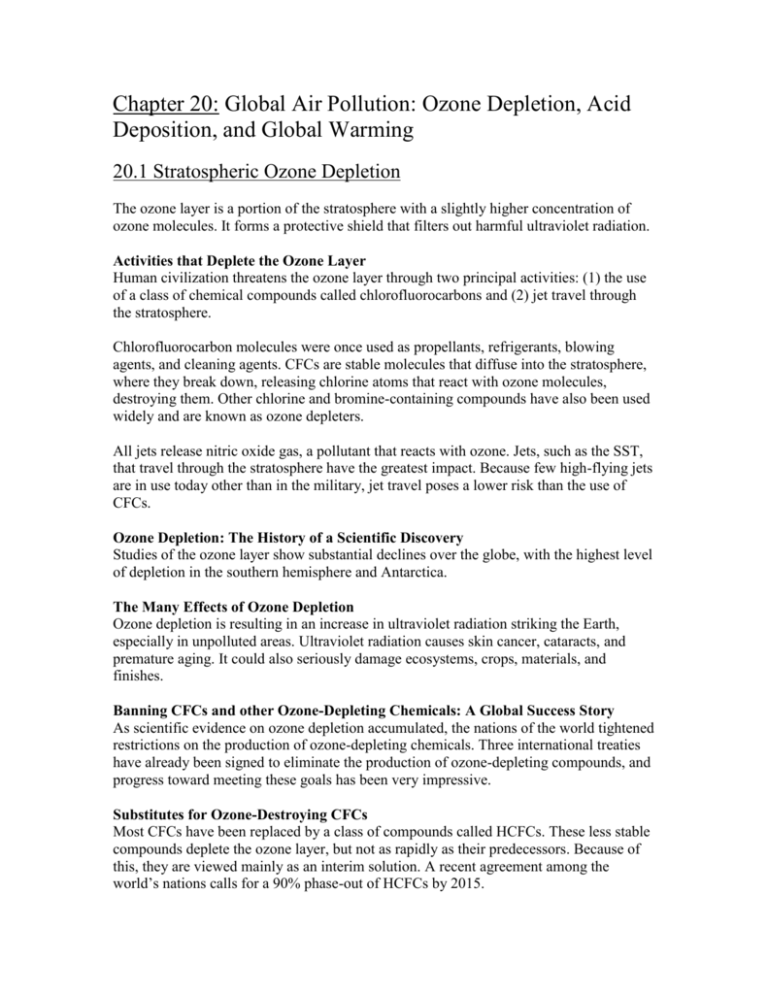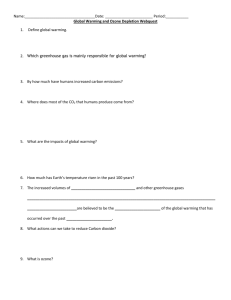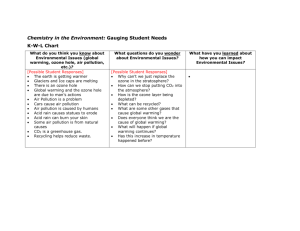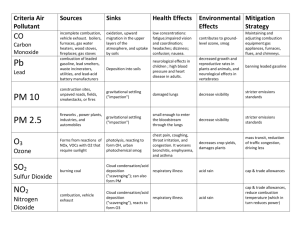Chapter Outline
advertisement

Chapter 20: Global Air Pollution: Ozone Depletion, Acid Deposition, and Global Warming 20.1 Stratospheric Ozone Depletion The ozone layer is a portion of the stratosphere with a slightly higher concentration of ozone molecules. It forms a protective shield that filters out harmful ultraviolet radiation. Activities that Deplete the Ozone Layer Human civilization threatens the ozone layer through two principal activities: (1) the use of a class of chemical compounds called chlorofluorocarbons and (2) jet travel through the stratosphere. Chlorofluorocarbon molecules were once used as propellants, refrigerants, blowing agents, and cleaning agents. CFCs are stable molecules that diffuse into the stratosphere, where they break down, releasing chlorine atoms that react with ozone molecules, destroying them. Other chlorine and bromine-containing compounds have also been used widely and are known as ozone depleters. All jets release nitric oxide gas, a pollutant that reacts with ozone. Jets, such as the SST, that travel through the stratosphere have the greatest impact. Because few high-flying jets are in use today other than in the military, jet travel poses a lower risk than the use of CFCs. Ozone Depletion: The History of a Scientific Discovery Studies of the ozone layer show substantial declines over the globe, with the highest level of depletion in the southern hemisphere and Antarctica. The Many Effects of Ozone Depletion Ozone depletion is resulting in an increase in ultraviolet radiation striking the Earth, especially in unpolluted areas. Ultraviolet radiation causes skin cancer, cataracts, and premature aging. It could also seriously damage ecosystems, crops, materials, and finishes. Banning CFCs and other Ozone-Depleting Chemicals: A Global Success Story As scientific evidence on ozone depletion accumulated, the nations of the world tightened restrictions on the production of ozone-depleting chemicals. Three international treaties have already been signed to eliminate the production of ozone-depleting compounds, and progress toward meeting these goals has been very impressive. Substitutes for Ozone-Destroying CFCs Most CFCs have been replaced by a class of compounds called HCFCs. These less stable compounds deplete the ozone layer, but not as rapidly as their predecessors. Because of this, they are viewed mainly as an interim solution. A recent agreement among the world’s nations calls for a 90% phase-out of HCFCs by 2015. The Good News and Bad News about Ozone The concentration of CFCs and other ozone-depleting compounds in the atmosphere has begun to decline. Despite this progress, the ozone layer will take many years to recover. Many people will contract and die from skin cancer. 20.2 Acid Deposition Acid deposition from pollutants is a global problem with serious social, economic, and environmental impacts. What Is an Acid? Acids are chemical substances that add hydrogen ions to a solution. Acids are measured on the pH scale, which ranges from 0 to 14, with 7 being neutral – neither acidic nor basic. What Is Acid Deposition? Rainfall in unpolluted areas has a pH of about 5.7 and is just slightly acidic. Acid deposition refers to rain and snow with a pH of less than 5.7 and the deposition of acid particles and gases. Acids reach the surface of the Earth either as wet deposition (rain or snow) or dry deposition (particulates and gases). Where Do Acids Come From? Acid precursors come from natural and anthropogenic sources, the latter being the most important. Of the anthropogenic sources, the combustion of fossil fuels is the most significant. The Transport of Acid Precursors Acid precursors can be transported hundreds of kilometers from their site of production to their site of deposition. Acid deposition occurs downwind from virtually all major industrial and urban centers. Acid deposition is increasing in strength (acidity) and expanding in geographic range. The Social, Economic, and Environmental Impacts of Acid Deposition Acid deposition has acidified lakes throughout the world. Hundreds of lakes no longer support aquatic life, and thousands are on the verge of ecological collapse. The buffering capacity of the soil and surface water – their ability to resist changes in pH – plays an important role in determining if a lake will be damaged by acid deposition. Acidity kills aquatic organisms outright, but it also impairs growth and reproduction. Acidity also leaches heavy metals, which are toxic to fish, from the soil. The spring snowmelt results in a sudden influx of acids and heavy metals that is highly damaging to aquatic life. Acid deposition affects birds living near lakes and aquatic species such as salamanders, which are a key element of the food chain. Acid deposition damages forests in many parts of the world and may affect crops as well. Trees and other plants are damaged directly by acids but also indirectly, through changes in the soil chemistry and soil-dwelling organisms. The sulfur and nitrogen in sulfuric and nitric acid promote plant growth, but their negative effects (such as direct damage and changes in the soil chemistry) typically outweigh any benefits resulting from their fertilizing effect. Damage to Materials Acids cause billions of dollars of damage to priceless statues, buildings, and materials. Solving a Growing Problem – Short-Term Solutions Many stopgap measures have been initiated to help reduce the threat of acid deposition, including the installation of smokestack scrubbers, combustion of low-sulfur or desulfurized coal, and liming lakes to neutralize acidity. Such measures are necessary in the short term but must eventually be replaced by long-term, preventive actions. Long-Term Sustainable Strategies Fuel efficiency, renewable fuels, recycling, population stabilization, and growth management are key elements of a sustainable design strategy to help prevent the production of acid precursors—and hence reduce acid deposition. Are Controls on Acid Deposition Working? Market-based strategies, in particular tradable permits, have proven successful in reducing sulfur dioxide emissions in the United States, with corresponding changes being seen in the acidity of rainfall as well as many lakes and streams. Still, Americans are a long way from the goals of reducing sulfur and nitrogen dioxide set out in the 1990 Clean Air Act. 20.3 Global Climate Change The Science Global Energy Balance and the Greenhouse Effect Much of the sunlight striking the Earth and its atmosphere is converted into heat and is eventually radiated back into space. Natural and anthropogenic factors affect the amount of solar radiation striking the Earth and the rate at which heat escapes – and thus influence the temperature of the Earth’s atmosphere. Natural Factors That Influence Global Temperature The Earth’s climate shifts naturally as a result of many factors, including changes in solar activity and volcanic activity as well as changes in the Earth’s orbit and the tilt of the Earth. Anthropogenic Factors That Increase Global Temperature Greenhouse gases come from natural and anthropogenic sources, the latter of which have been increasing dramatically over the past 60 years. Are Global Warming and Global Climate Change Occurring? Evidence clearly shows that global warming is occurring and that the climate is changing as a result. Are Human Activities Causing Global Warming? While natural forces affect global warming and global climate change, human activities appear to be the main driving forces. Predicting Future Effects of Global Warming and Global Climate Change Scientists predict a climatically significant increase in temperature over the next 100 years that could result in a rise in sea level with potentially devastating effects on coastal populations and ecosystems. Global temperature increases could shift rainfall patterns, increasing precipitation in some areas and decreasing it in others. Too little rain in some areas and too much in others could have a profound effect on food production and the economy. Computer models and current evidence suggests that rising temperatures could result in more violent and costly storms, including tornadoes and hurricanes. The Ecological and Health Impacts of Global Climate Change Organisms and ecosystems could be profoundly influenced by global climate change, especially if the rate of change occurs faster than their ability to adapt, which seems inevitable. Cooling and Changing Ocean Currents Scientists believe that melting glaciers and increased rainfall in the northern latitudes could infuse the ocean with less dense, cool fresh water that could shut down the normal circulation of sea water. Studies of ocean currents and climate suggest that such changes could occur abruptly and soon. As a result, global warming could bring on ice-age conditions in northern Europe. National and International Security Global climate change is not just an economic and environmental issue; it has potentially serious implications for global peace. Scientific Uncertainties: What We Don’t Know Many factors could complicate predictions of future climate. Some factors could result in a runaway increase in atmospheric CO2 levels, which would accelerate warming. Others could reduce warming. Solving a Problem in a Climate of Uncertainty: Weighing Risks and Benefits Some uncertainty exists on global climate change, which has slowed progress. Even though there are some uncertainties, many people believe that the costs of reducing or even eliminating greenhouse gases are outweighed by the potential social, economic, and environmental costs of global climate change. Solving the Problem Sustainably Redesigning human systems according to the principles of sustainability could help alleviate the problem of global warming and help create a prosperous, safe future. Stabilizing population growth can help reduce humanity’s need for fossil fuels and other greenhouse-enhancing activities such as deforestation. Restoring forests, especially in the tropics, and restoring other carbon sinks like wetlands, could have a profound effect on global carbon dioxide levels. Recycling and energy efficiency greatly reduce energy demand and cut greenhouse gas emissions. Renewable energy technologies can provide us with much-needed power, with little or no impact on global climate.








